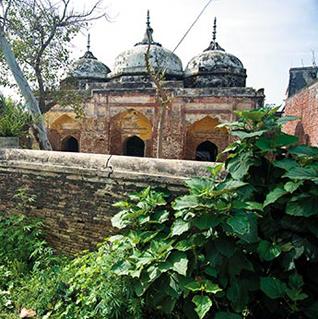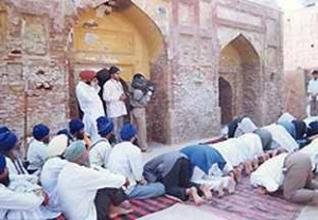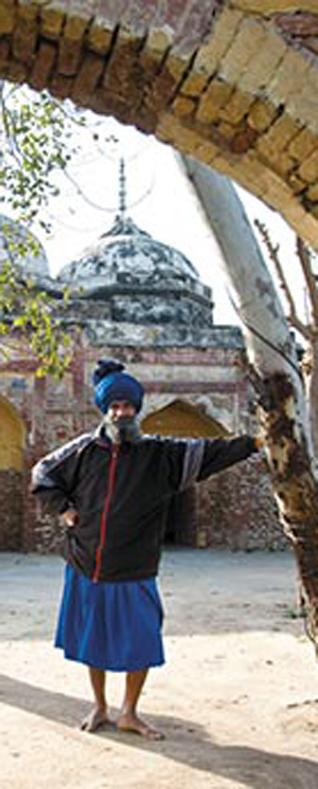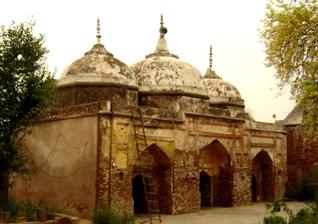Travel
Guru ki Maseet: A Rich Tapestry
by ANNA BIGELOW
As the light in the gurdwara courtyard grew golden, an unusual meeting took place between Baba Kirtan Singh, head of the Nihang Taran Dal in Baba Bakala, and Dr Mohammad Rizwanul Haque, Secretary of the Central Wakf Council, Delhi. The two men sat facing each other on simple string charpoys to discuss their shared interests in a masjid built by a Sikh Guru.
It was like observing master weavers at work as they interlaced two of the many threads that make up the rich tapestry of Punjab's religious and cultural fabric. Dr Haque sat leaning forward, listening raptly in order to make out the wavering but urgent voice of the elderly Sikh.
Baba Kirtan Singh had come prepared, bringing with him several texts of Sikh history, some written in Gurmukhi and others in Persian script. He read from the records about the Sikh Guru’s conversion of the house of a dead Muslim into a masjid and the setting up of a langar for the poor. He also told of an encounter between Guru Nanak and some Muslims that ended with the declaration that "if Hindus are the left hand, then Muslims are the right, and we all believe in the one true God."
In this way, Baba Kirtan Singh skillfully wove together the history of the Gurus and the present situation, the preservation and maintenance of a place - the Guru ki Maseet in Sri Hargobindpur - that is precious to both the communities.
The maseet (mosque) is picturesquely situated on a hill overlooking a curve in the mighty Beas river. After coming to the region in the early 17th century, Guru Hargobind built temples, gurdwaras, and a masjid to accommodate the spiritual needs of all the inhabitants. Since Partition of Punjab and India, there has been no Muslim population in the area. In the intervening years, the care of the site was taken up by Nihangs sent by Baba Kirtan Singh from his base in Baba Bakala, some 20 kilometres away.
The present sevadar, Baba Balwant Singh, has been at the site since 1984, clearing weeds, sweeping dust, preparing langar, and fulfilling all the other obligations of his faith in service to the Guru, his Baba, and the Sikh tradition.
However, some hurdles had to be cleared. The area around the maseet had been encroached upon, the hillside was eroding and needed shoring up, and the local residents seemed largely unaware of this unique treasure and were not entirely comfortable with the Nihang presence at the site. Furthermore, a bir of the Guru Granth Sahib had been placed within the mosque and a Nishan Sahib erected near it, making the building’s identity as a maseet questionable.
As the restoration work began, the encroachment was cleared and the land cleaned up. A neighbour donated a piece of land and further property was purchased by CRCI with the assistance of UNESCO and the Sikh Foundation. Local residents contributed their time and energy to the site by organising a large seva with a langar that brought people from the entire region to the maseet - to see it, learn about it, and help it survive. People who had initially been skeptical or even afraid of the Nihangs began to learn about their beliefs and practices and now frequently and unhesitatingly visit the site to see the progress of the project.
Finally, a new space was built and the Guru Granth Sahib was moved out of the maseet. Various officials from the local Wakf Board, members of the SGPC, MLAs and Members of Parliament have visited the maseet and responded to queries from members of their communities who wished to know about the status of the site. All of these events culminated in the meeting between Dr Haque and Baba Kirtan Singh in order to determine the future of the Guru ki Maseet.
The white-bearded elderly man in the blue and white turban sitting on one charpoy with his pile of books lovingly wrapped in cloth contrasted sharply in appearance, age and religion with the much younger, clean-shaven man in western clothes perched across from him. Yet at this meeting their unity of purpose and the similarity of their thinking was equally apparent.
Seeking common ground, Dr Haque had traveled a long and bumpy road from Delhi to Punjab to find Baba Kirtan Singh at his gurdwara. Baba Kirtan Singh had also made a long journey - into the annals of Sikh history to discover precedents from the past that would strengthen the bonds of the two communities. The two men made great efforts to understand each other, to hear and be heard as they discussed the ways in which both communities could simultaneously live up to their interest and obligations to preserve and maintain the Guru’s maseet.
They were helped in speaking to each other across languages and traditions by the translations of Punjab Wakf Board CEO Ikhlaq Ahmad Khan and CRCI Director Gurmeet Kaur Rai. As the conversation proceeded in Punjabi, Hindi and Urdu, the matter was clarified and an understanding reached. The Guru had built a masjid.
As Baba Kirtan Singh put it, "This maseet was established by our Guru. It is a maseet, but it is as important to us as a gurdwara."
Dr Haque echoed this sentiment, declaring, "Your Guru built a maseet and it was his intention that Muslims come and perform namaz there. There are no Muslims now, but you (the Nihangs) have been preserving it very well and we all want it to stay in its original form." Later Baba Kirtan Singh stated that just as Muslims testify to the oneness of God, Sikhs say Sat Sri Akal. He again assured Dr Haque and the other representatives from the Wakf Board that they should not worry at all, the building would be kept as a maseet, as the Guru had wanted.
If the Guru built a mosque, it should be understood as more than a conciliatory gesture towards the other community. It was an act of community-building by a leader whose Miri-Piri sensibilities were steeped in the devotional traditions of Guru Nanak, Baba Farid, Kabir and Namdev. The masjid is not simply a place sacred in various ways to these separate religions. It is an important symbol of the integrated past and present of Punjab’s cultural heritage.
The maseet as a Muslim space also represents the deeply held principles of equality in Islam. This value is visible in the structure of the mosque itself. The horizontal orientation maximizes the proximity of the faithful to Mecca. It is further evident in the accessibility of the space to all people. Everyone is welcome here in a space that is designed to reflect the oneness of God and the importance of community. There is no rule in Islam against the participation of non-Muslims in the care of a Muslim shrine. On the contrary, there are countless precedents for the collective custody of such places. The only rules pertaining to who may or may not enter a masjid, or for that matter, a gurdwara, are rules of adab, or right conduct, by which one shows respect to God, the place, and the assembled people, and oneself by entering in a state of bodily cleanliness with a covered head, bare feet, and a reverent attitude.
The crucial lesson to learn from this encounter is that these two leaders made deliberate and sincere efforts to meet each other, and to forge, rather than sever, the bonds between their two communities. Instead of seeking precedents and principles that would establish priority of their own claims and interests in the property, both strove to find the events and ideas of the past that would support their sharing of the maseet’s maintenance. In this way they established that sharing the responsibilities that both groups want to assume in the future care of the mosque is a fulfillment of the principles of their faiths.
They further demonstrated that this
joint project was simply one more example of Punjab’s proud heritage of
pluralism.
With the leadership of people like Dr Haque and Baba
Kirtan Singh and the support of the Muslim and Nihang communities,
neighbours, visitors, and benefactors, the Guru ki Maseet has every hope
of surviving and providing future generations with yet another historic
precedent for their efforts to live together in an increasingly plural
and diverse society.
With the sound of the evening Rehras (Sikh evening prayer) permeating the air, providing a soothing sonic background, an agreement to this end was reached - the Guru ki Maseet is a mosque and should remain such, as per the wish of Guru Hargobind. The Nihangs who have cared for and respected the site for so long would continue to oversee its upkeep. The Guru Granth Sahib is in a newly built room at some distance from the maseet.
The locals of Sri Hargobindpur, who take increasing pride in their unique monument, will continue to support the place, doing seva there and executing plans for a community centre with a garden and library. Muslims who come are free to perform namaz. And visitors from all over the world will have the opportunity to see the Guru ki Maseet as a living example of the depth of Punjab’s integration, past and present.
Anna Bigelow is Assistant Professor of Religion and Philosophy at North Carolina State University. This article was first published in the Tribune a decade ago.
[Edited for sikhchic.com]
May 21, 2011
Conversation about this article
1: Sangat Singh (Kuala Lumpur, Malaysia), May 21, 2011, 1:38 PM.
"Bisar ga-ee sabh taat paraa-ee/ jab tay sadh sangat mohi paa-ee/ naa ko bairee naheee bigaanaa sagal sang ham ko-a ban aa-ee/ jo prababh keeno so bhal maani-o ayh sumat saadhoo tay payee" [GGS:1299.14] - "I have forgotten my envy of others since I have found the holy saadh sangat. No one is my enemy, and no one is a stranger. I get along with everyone. Whatever God does, I accept that as good. This is the sublime wisdom I have obtained from Satguru."
2: Jesroshan Singh (Malaysia), May 22, 2011, 2:01 AM.
I can't believe that first the Muslims took half of Punjab for Pakistan and now they are encroaching upon our Punjab in India. It may be a maseet, but it was built by our Guru. Thus it is ours and not for any Islamic Wakf Board to come and say it is theirs.
3: Navreet (Australia), May 23, 2011, 12:06 AM.
That is an amazing piece of history. It reflects the fundamental Sikh values of universal brotherhood and of respect and acceptance of others, irrespective of their faith/ religion/ beliefs. We rarely see such an act of humanity today, where we're all too busy creating and finding differences between 'us' and 'them'. May we all understand and live in the true spirit of Sikhi.
4: Brijinder Khurana (Delh, India), May 24, 2011, 5:59 AM.
Makes me proud to be a Sikh!
5: Kamaldeep Singh (London, United Kingdom), May 24, 2011, 10:26 AM.
With the the greatest respect, it reflects nothing but the lack of acumen Sikhs possess as a collective. It has hardly been 60 years since Punjab and India were torn asunder though the very heart of Sikhdom and we are bizarrely resurrecting mosques for a Muslim population that is not even there. This is nothing but hari-kari of the highest order. Muslims are not building synagogues for Jews in Palestine and then trying to retain an Islamic hold on the area for obvious reasons. This is extreme folly. God save us.
6: Sangat Singh (Kuala Lumpur, Malaysia), May 25, 2011, 6:07 PM.
Must we sully the name of Sikhi and become parochial and descend to the lowest ebb and go 'tit for tat'. Or, re-write Bhai Kanhaiyya's 'samdrishti' as a colossal mistake in treating the fallen enemy the same as the Sikhs. Or, find fault with Guru Hargobind for building the maseet in the first place. Or, find gurbani's edict as out of place when it extolled: "Naa ko bairee nahee bigaanaa sagal sang ham ko-o ban aa-ee" [GGS:1299.14] - "No one is my enemy, and no one a stranger. I get along with everyone." There was an episode of a Nihang Singh who started to work on a road starting from his hut in the village, single-handedly. When asked what he was doing: "I am building a road to Anandpur Sahib!"






